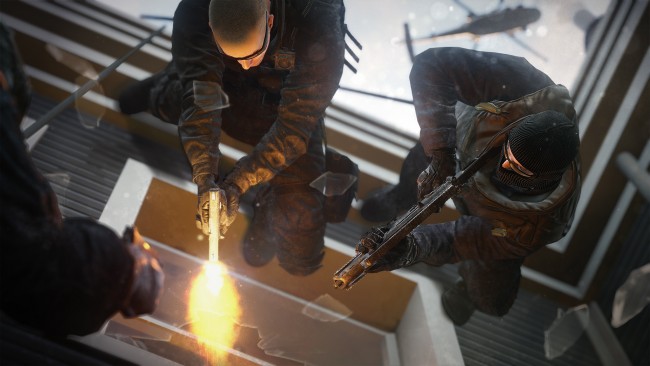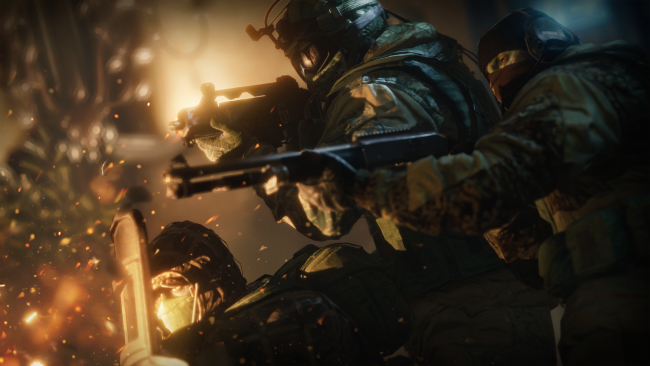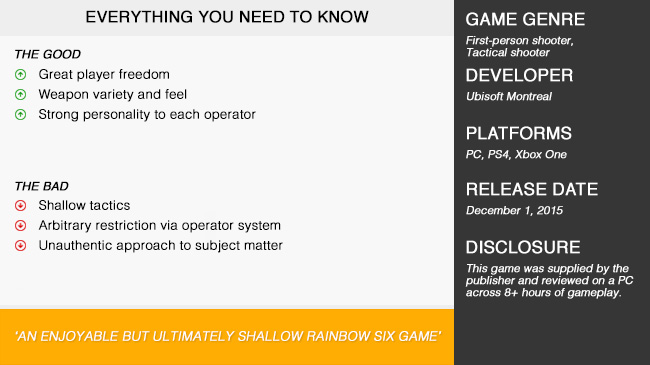
A key element of tactical shooters, perhaps one that many would consider foundational to their very definition, is an emphasis on tactics. Formulating a plan that utilises the strengths of your group is what tactics is all about, not just executing a reckless strategy with mad 360 noscopes. Simply running in and blasting every wall doesn’t work when you’re dealing with unknown variables, and Rainbow Six Siege understands this, more or less. It’s taken the Rainbow Six franchise back to its roots, but it’s far from being as intricate and precise as a well-played game of chess.
Before I rip into it, let’s all take a moment to revel in the fact that Siege isn’t a cover-based shooter. Yes, we had our fun in Vegas, and yes, it was as true to the franchise as the last season of Scrubs (which never happened), but we’re out of those flashy times now. Siege channels the early days of Rainbow back into the franchise, rewarding careful positioning and teamwork over running and gunning. I’m more than happy to embrace the good ol’ days of tactical shooters, and Siege does a good job of fostering that tension of the old games.

The original R6 games were not a relaxing experience, and Siege does a lot to bring that tension back through player freedom. You won’t know where the opposing side is hiding or coming from, but they have the means to approach from almost any angle at any given time. Because of the destructibility of the environment, attackers can breach through walls, and defenders can be easily caught off guard with a split attack. Defenders have their set of tools as well, including booby traps and reinforcing walls, and this freedom goes a long way in keeping you on your toes throughout a game. Unfortunately, this feels shallow compared to what could have been.
For a game that holds planning on a pedestal, it doesn’t play a very big role. Games consist of rounds, and each round has two phases. In the planning phase, the defenders set up their defences while the attackers send in drones to try and find them. Then comes the attacking phase, but you haven’t set up a plan, you’ve just got a vague idea of where to go (assuming you found the objective). There’s no uniform selection, no map to set up waypoints, no agreed upon approach, just what you found out at the last minute and a gung-ho attitude.

A lack of a formal planning system (or even a freakin’ map) just makes the game feel like another run-n-gun shooter with destructible terrain. Sure, you can consult with your teammates (which is downright required in ranked), but you’re just formulating on the fly in a map you’ve learned by rote. You haven’t set up anything, you’re not employing any strategy, and I’ll be damned if Rainbow, a multi-national ‘blacker than black’ counter-terrorist unit, don’t have access to a map of a government building. It comes across like a shitty CS: GO instead of a tactics-heavy shooter, but the gunplay and destructible environments work in its favour.
Even though the game lacks any formal planning system, the gunplay lends itself to tactical thinking. The destructible terrain isn’t an all or nothing deal, so you can bash a hole through a door and peek through to stay concealed. You can shoot through most walls and peer through to get a clean shot, which is surprisingly hard to do! Shooting your opponent isn’t difficult, but seeing them and lining up a shot can be. It’s a game that rewards positioning over reflexes, and that’s great, but it ultimately feels a bit simple.

Here is where I get a bit torn over the game. Ubisoft has done a great job of bringing the franchise back into what made it enjoyable in the first place, but it hasn’t shed its simplicity just yet. Siege doesn’t allow players to choose their loadout freely, opting instead for an ‘operator’ system (think champs in MOBA’s) where each class has unique abilities. The operator system forces players to work together to take advantage of their different abilities, but it ultimately restricts players in ways that seem arbitrary. Each operator can only take certain weapons and items, so depending who you picked/are forced to take, you can’t take breach charges. Why?
Restricting weapon choices is so strange because it not only makes no sense to me mechanically, it makes even less sense narratively. Rainbow Six is quite literally the crème de la crème of special forces operatives, and saying that IQ can’t take frag grenades because that operator can’t take them is absurd. I would have preferred to see a proper loadout system because weapons do feel very different to one another, but the operator system negates the fact that guns can swap between people. It all feels like tactics are lost in the name of accessibility, and while that’s understandable, it’s detrimental to the final product. Focusing on accessibility feeds into the problem of style over substance, both in gameplay and presentation.

The big issue I have with the game is that it chooses to look cool over authenticity. Let’s take IQ as the illustrative example here. IQ is a light character, so she has very little armour and can move more quickly, but when you see her in a hoodie and jeans, is your first thought GSG9? She looks cool, sure, but no self-respecting military official would let her out in just a hoodie and jeans. Operators look the part while looking cool, but in doing so, they don’t look the part at all. Again, they look cool, but it doesn’t make the experience all that authentic, it just helps establish their personality, which can be helpful.
If you’re willing to suspend your disbelief and look past the ludicrous character design, it’s simultaneously really good and really lacklustre. All the operators are visually reflective of what they specialise in, but this can also mean that some operators are walking clichés. Thatcher, an SAS operator that carries EMP grenades, delivers the single greatest introductory cutscene of the entire game with one line. Kapkan, a Spetznaz operator who loves setting up traps for his prey, is as original as my jokes, but that’s just what happens when you chuck this many personalities into a game. Of course, don’t expect any of them to get much more than a brief backstory since there is no story to this game whatsoever.

If you’re wondering why I’m not rating the game based on narrative, it’s because there isn’t one. Siege is a multiplayer focused, story-lax game that offers the barebones semblance of a plot through vague mentions of terrorism and sieges. I must be the only person that read the Rainbow Six novel (I only remember the weird sex scene), but it seems like a huge loss for the game not to have mentioned Clark or Chavez somewhere. If it’s going back to its roots, why not take advantage of the strong narrative of its predecessors? Still, this is a multiplayer game, and I can’t blame Ubisoft for not worrying too much about the story, and I doubt it would have saved the game for me.

Tom Clancy’s Rainbow Six Siege is undeniably enjoyable, but as far as tactical shooters go, it’s not the best. It’s CS: GO with destructible terrain, a focus on positioning, and arbitrary restrictions on your loadout. It’s a shallow game, but it offers plenty of freedom to approach a situation from various angles. It’s a disappointment that there was no dedicated planning screen (or even a map!), especially since that’s what R6 was about, but it’s truer to the series than Vegas ever was. A nice callback, sure, but a return to form? Hardly.











